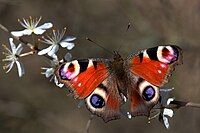
Photo from wikipedia
Abstract The aphids Lipaphis pseudobrassicae (Davis) and Myzus persicae (Sulzer) (Hemiptera: Aphididae) are important Brassicaceae pests, occurring worldwide and causing significant damage to crops. Interspecific variations in the resistance to… Click to show full abstract
Abstract The aphids Lipaphis pseudobrassicae (Davis) and Myzus persicae (Sulzer) (Hemiptera: Aphididae) are important Brassicaceae pests, occurring worldwide and causing significant damage to crops. Interspecific variations in the resistance to natural enemies can potentially impact the interaction among aphid populations. Here we evaluated the hypothesis of associational resistance by determining if the presence of resistant aphids (L. pseudobrassicae) reduces the rate of parasitism by Diaeretiella rapae (McIntosh) on non-resistant aphids (M. persicae). The experiment was conducted using collard green plants infested with M. persicae and L. pseudobrassicae either resistant or susceptible to D. rapae. The percentage of parasitism by D. rapae was greater on L. pseudobrassicae in the susceptible than in the resistant treatment, but parasitism rates on M. persicae did not differ between the treatments. There was no difference in average growth rate between M. persicae and susceptible L. pseudobrassicae populations, but resistant L. pseudobrassicae had greater growth rate than M. persicae. These results suggest that over a short period of time the presence of resistant L. pseudobrassicae does not affect the rate of parasitism by D. rapae on M. persicae.
Journal Title: Revista Brasileira De Entomologia
Year Published: 2018
Link to full text (if available)
Share on Social Media: Sign Up to like & get
recommendations!